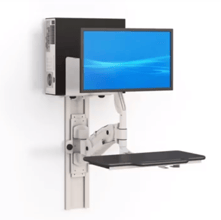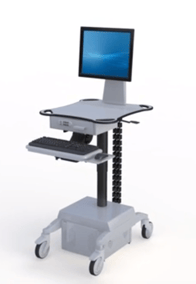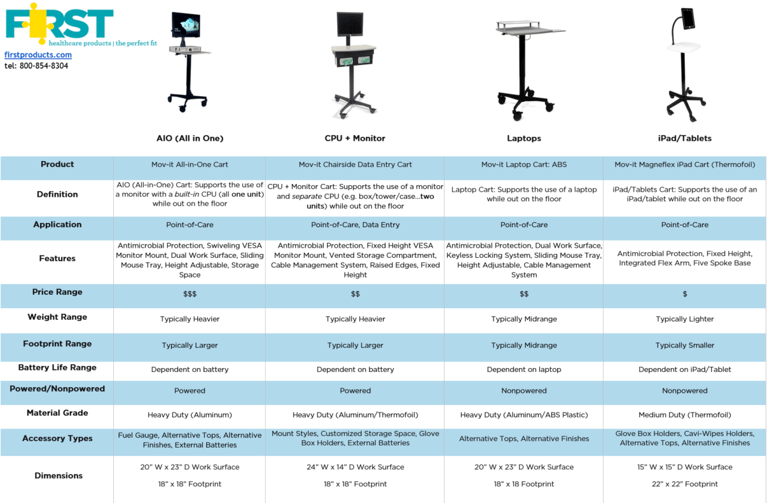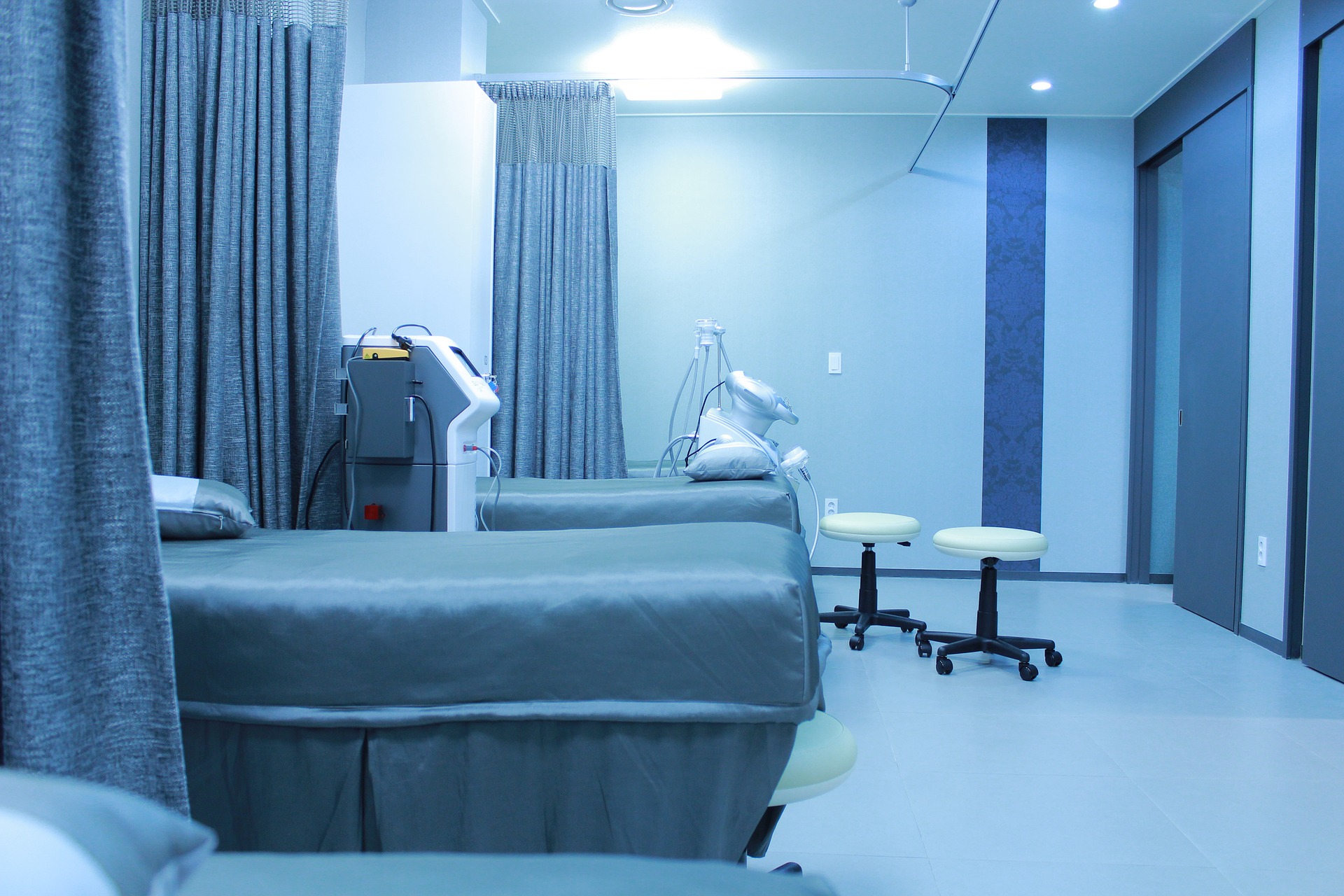By FHP on Apr 3, 2018 2:39:36 PM
INTRO
While the rolling out of EMR/EHR mandates in the United States has brought about some positive change within the healthcare community, there still exists some serious growing pains among caregivers and practitioners. Many factors come into play when discussing the dissatisfaction surrounding EMR/EHR, but one topic that always seems to find a way to rear its head is hardware and equipment.
There is plenty of evidence out there suggesting that EMR-related equipment is a continual source of headaches for practitioners. According to one study done by Ergotron, "49% [of nurses] report feeling some level of discomfort inputting charting data into a computerized point-of-care solution". ¹ Dakota State University asked 17 physicians to rate their "perspective on hardware, performance, and configuration aspects of EHR"; all 17 gave negative responses. ² It's clear when considering studies like these that there remains some fundamental misgivings with the equipment (or lack thereof) adopted by facilities to meet EMR/EHR standards. This brings about an important question, one we'll discuss and explore further within in this article: What are Health IT Vendors doing to address caregiver dissatisfaction with EMR hardware and equipment?
Other topics we'll touch upon within this article:
- How and why charting IT equipment has changed over the years
- Why facilities are moving toward mobile rolling medical carts
- A comparison of the four main types of rolling medical carts and how to choose the one that is right for your use case
THE TRENDS OF THE PAST
Technology exists in a constant state of flux, meaning that things like product design, product expectations, and user demands are always changing. The truth is what drove the equipment market when EMR/EHR was first implemented is much different than what drives it now.

For example, wall mounted stations were quite a popular solution back when EMR mandates were freshly enacted. Dedicated, fixed stations for record-taking and data entry seemed like a great option for optimizing ergonomics and engaging with patients at the time. Unfortunately, with hospitals facing problems like cutbacks and understaffing, practitioners discovered that the immobility of these stations were a severe drawback to their workflow. Put simply, the wall station had to be transportable/move with a caregiver (and wall stations, by definition, did not). The wall station just couldn't keep up.
So along came the Workstation-on-Wheels. WOWs—or sometimes called COWs (Computer-on-Wheels)—are wheeled mobile carts equipped with PCs or laptops. WOWs have proven to be beneficial to caregivers for a number of reasons. Here are some listed below: ³
- WOWs can be rolled into multiple rooms for individual patient's EMR/EHR use (vs. having one single unit in each room)
- Patient engagement is easier and more efficient thanks to a WOWs high level of mobility and adjustability
- WOWs reduce things like typos, errors, and misunderstandings while documenting
- WOWs give facilities the option to recycle older laptops, PCs, and monitors
Another unique feature of the WOW is its ability to handle a battery system. These battery systems—which are often integrated into the design of the cart itself—allow for different types of devices to be used to display patient information. Carts with a battery already integrated, called "powered" carts, can handle devices that require a constant feed of electricity (like CPUs and monitors). Carts without a battery integrated, called "nonpowered" carts, can support devices that don't necessarily need a source of power to function (like laptops and tablets). Having a battery-equipped WOW essentially transforms a cart into something of a mobile mounted wall station. This proves extremely desirable to caregivers who are constantly on the move.

Facilities that purchased these WOW carts early on, however, ran into setbacks from the get-go. A major issue plaguing these early models was the footprint of the cart itself. The amount of space these WOW carts took up was simply too great to be considered a substantial upgrade from previous solutions. As displayed in the picture to the right, the batteries integrated into these carts had to be stored somewhere—and they usually found their way into the base of the cart. This made WOWs clunky, bottom-heavy, and more of a space hog than a standard cart. While something like having issues with footprint size may come across as nitpicky, consider this: 42% of nurses cite "lack of space to maneuver technology" as a "barrier to using computerized devices at a patients bedside". 1 Maneuverability and handiness are obviously important to nurses (and, by principle, pretty much all caregivers), so Powered WOWs didn't exactly live up to its expectations or hype either.
This concept of equipment not quite meeting the needs of a caregiver is an important one, because it reflects that there exists a disconnect between those who create equipment and those who use it. Now more than ever, caregivers are pressured to be with the maximum amount of patients in the minimum amount of time. Since practitioners rely on their equipment to facilitate this, Health IT Vendors need to step up to provide equipment that gives caregivers the edge they need. We believe our current line of rolling medical carts has the ability to meet the active and demanding workflow of caregivers (instead of forcing them adjust or change their own).
THE TRENDS OF NOW
Before diving into our catalog, it'd be beneficial to look at the trends that are driving the EMR/EHR hardware market today. After all, these trends are a reflection of the needs and desires of caregivers that use EMR hardware to begin with. A report titled Medical Cart Market Analysis by Product had this to say about current mobile cart trends:
"Increasing adoption of mobile carts can be attributed to the availability of technologically advanced products that offer better configuration, construction, options, and features to meet requirements of consumers...Advancements such as improved mobility, lighter weight designs, and enhanced ergonomics are expected to boost the adoption of these medical carts." 4
As we've seen with the rise and fall of wall mounted stations and powered WOWs, improved mobility and lighter weight designs are key factors in creating EMR hardware that both satisfies and lasts. We took these elements (as well as our signature approach to customized options and features) and worked to incorporate it all into our own line of rolling medical carts. Below is a chart that breaks down our line of carts and the different types of functions they serve:

OUR OFFERINGS (AND WAYS TO CHOOSE)
Our carts are divided into four separate categories: AIO (All-in-One), CPU + Monitor, Laptops, and iPad/Tablets. Each of these categories reflect a particular mode of EMR/EHR use; essentially, they are a reference to the device that the EMR/EHR technology lives on. For example, the Mov-it Laptop Cart: ABS is specially designed to house a laptop that runs EMR software, while the Mov-it All-in-One Cart will store a monitor with built-in CPU (running EMR software, of course).
Each category of carts has their own characteristics, functionalities, strong suits/weak points, and pros/cons to consider. Because of this, a facility looking to pick up a rolling medical cart will need to weigh out a plethora of factors before making a purchase (e.g. budget, type of healthcare environment, feature requests, etc.).
Here is a general guideline to follow to help you narrow down your options and select the type of cart that is best for you and your facility:
An AIO (All-in-One) cart might be your best bet if you're looking for...
- a desktop-style experience without the inconvenience of a CPU
- something reminiscent of a powered WOW without the awkwardness of older models
- a heavy duty, top-of-the-line solution that can used adjusted standing and sitting heights with ease
A CPU + Monitor cart is what you're after if you want...
- a more traditional desktop-style experience (complete with a CPU tower/station)
- a station optimized for data entry and the type of tasks that accompany it
- a station with additional storage options for anything from gloves to wipes
A Laptop cart will do you well if you're in the market for...
- a low-profile and lightweight solution to EMR equipment
- a way to recycle and reintegrate older laptops into a facility's workflow
- an EMR experience similar to that of a wheeled computer desk
And there's always the iPad/Tablet cart if you're searching for...
- the most budget-friendly of solutions (that doesn't sacrifice quality for price)
- a viable method for mass tablet deployment within your facility
- a solution that allows you to detach and reattach your iPad/Tablet for extra on-the-go care
CONCLUSION:
EMR/EHR hardware and equipment has come a long way from its modest beginnings in 2013. Analyzing the successes and failures of this market's past proves to be an insightful endeavor—it allows observers to pick up on which features/functions are beneficial to caretakers and which aren't. This intimate understanding of past trends is what drove us to build our own line of rolling medical carts. There's a simple logic to taking what plainly works and ditching what obviously doesn't; and we at First Healthcare Products believe it's a logic that should also apply to EMR hardware. Offering ergonomic & customizable solutions is our ultimate mission—and we hope you consider us in helping you find your perfect fit for EMR/EHR.
References:
1) Hospital Rx: Nurse Health & Patient Experience Graphic. https://www.ergotron.com/en-gb/support/resource-library/infographics/nurse-health-patient-care
2) Meaningful Use of Electronic Health Records for Physician Collaboration: A Patient Centered Health Care Perspective. http://ieeexplore.ieee.org/stamp/stamp.jsp?tp=&arnumber=6758683
3) Benefits of Workstations on Wheels in Healthcare. https://www.addondata.com/2017/09/benefits-of-workstations-on-wheels-in-healthcare/
4) Medical Carts Market Analysis By Product. https://www.grandviewresearch.com/industry-analysis/medical-carts-market
Photo: Pictures by Vital Works via Pixabay
_11wX8.5h-FINAL.png?width=721&name=FP-Logo-Horizontal-(COLOR)_11wX8.5h-FINAL.png)




comments